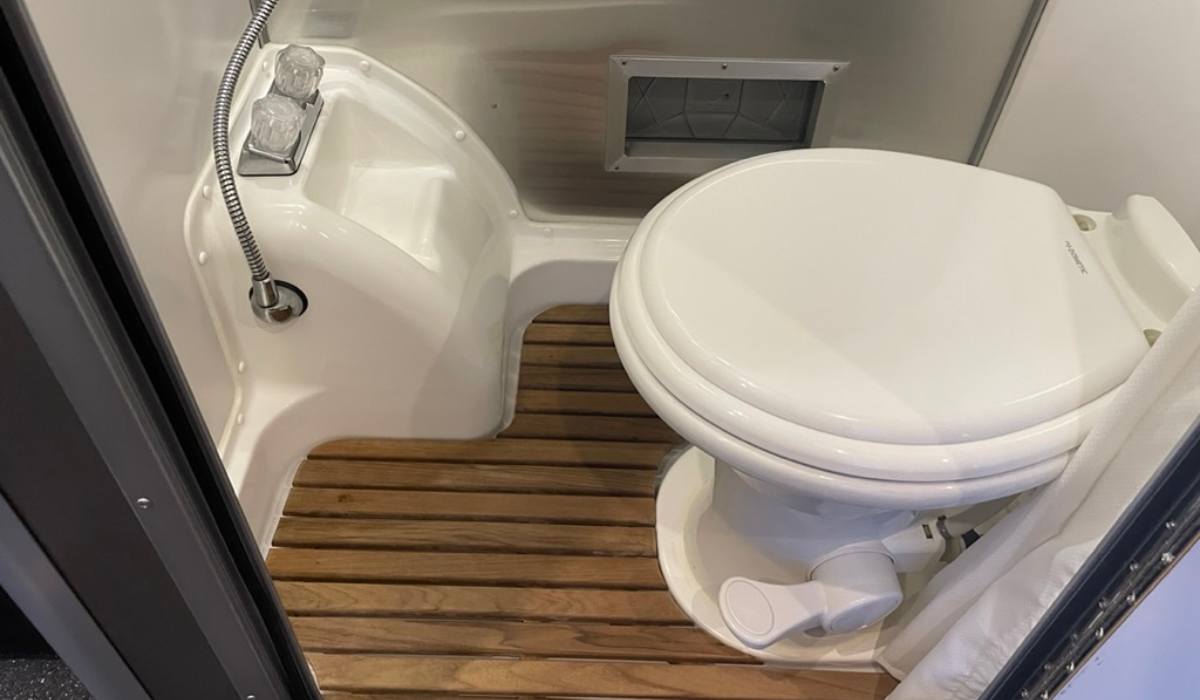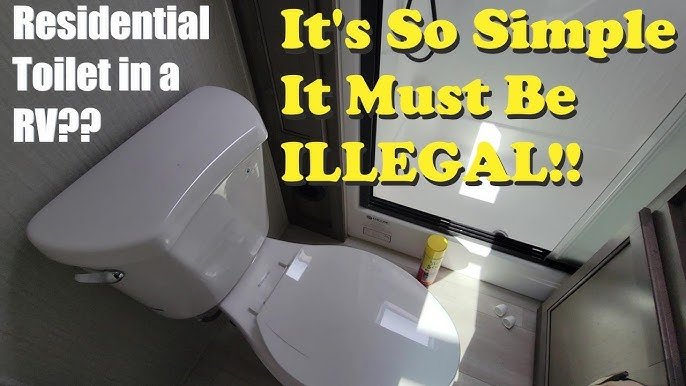Yes, you can put a residential toilet in an RV. But there are several factors to consider.
RVs typically come with their own specialized toilets. These are designed to handle the unique needs of mobile living. But sometimes, an upgrade to a residential toilet may seem appealing. Residential toilets offer more comfort and familiarity. Before making the switch, it’s important to understand the differences.
Residential toilets use more water and may require plumbing adjustments. Additionally, space constraints in RVs could pose challenges. This blog will explore the pros and cons, installation tips, and potential issues. By the end, you’ll know if a residential toilet suits your RV lifestyle.
Types Of Rv Toilets
When outfitting your RV with a toilet, you have several choices. Each type of RV toilet offers its own benefits and limitations. Understanding these can help you make the best decision for your needs. Here’s a look at the main types of RV toilets.
Cassette Toilets
Cassette toilets are common in many RVs. They have a fixed toilet bowl inside the RV. The waste goes into a removable tank. You can easily detach this tank and empty it at a dump station. These toilets are practical and user-friendly.
Portable Toilets
Portable toilets are an excellent option for small RVs. They consist of two parts: a toilet seat and a waste tank. The waste tank can be detached and emptied manually. These toilets are easy to move and set up. They are ideal for short trips.
Composting Toilets
Composting toilets are eco-friendly and waterless. They use natural processes to break down waste. These toilets separate liquid and solid waste. This helps reduce odors. They are perfect for off-grid living. However, they need regular maintenance to function well.
Gravity Flush Toilets
Gravity flush toilets are similar to residential toilets. They use water to flush waste into a holding tank. These toilets are comfortable and effective. They need a reliable water supply. They also require regular emptying of the holding tank.
Benefits Of Residential Toilets In Rvs
Installing a residential toilet in an RV can bring numerous benefits, enhancing your travel experience. Residential toilets offer comfort, ease of maintenance, and a homely feel. Let’s dive into the specific benefits of having a residential toilet in your RV.
Comfort And Convenience
One of the main benefits of a residential toilet in an RV is the comfort it provides. Residential toilets are typically more comfortable than standard RV toilets. They have a larger seat and better flushing mechanisms. This makes them feel more like the toilets you are used to at home.
Moreover, residential toilets often have better water pressure. This ensures a more efficient flush. Additionally, they come in various designs and heights. You can choose one that best suits your comfort needs.
Ease Of Maintenance
Residential toilets are generally easier to maintain. They are built with durability in mind. This means fewer repairs and issues over time. Many residential toilets also have parts that are easy to find and replace.
Cleaning is also simpler with residential toilets. Their design allows for easy access to all parts. This ensures that you can keep your toilet hygienic without much hassle. Some models even come with self-cleaning features, adding to the ease of maintenance.
Here’s a table to summarize the key differences:
| Feature | Residential Toilet | Standard RV Toilet |
|---|---|---|
| Comfort | High | Moderate |
| Water Pressure | Better | Standard |
| Ease of Maintenance | High | Moderate |
| Durability | High | Moderate |
Installing a residential toilet in your RV can significantly improve your travel experience. The comfort and ease of maintenance are just a few of the benefits. Consider these points when deciding on upgrading your RV toilet.
Challenges To Consider
Installing a residential toilet in an RV sounds like a great idea. But there are several challenges to consider. From space constraints to plumbing issues, each factor plays a crucial role. Understanding these challenges can help you make a well-informed decision.
Space Constraints
RVs have limited space. Residential toilets are often larger than RV toilets. This means they may not fit in the existing bathroom area. You might need to remodel the bathroom to make space. This can be costly and time-consuming. Also, more space for the toilet means less space for other amenities.
Plumbing And Installation Issues
Residential toilets use more water than RV toilets. RV plumbing systems are designed for low water usage. Adapting the plumbing system to a residential toilet can be difficult. You may need to install a larger holding tank. This adds to the complexity and cost. Additionally, RVs are mobile. The vibrations and movement can affect the stability of a residential toilet. Proper installation is crucial to prevent leaks and damage.
Installation Process
Installing a residential toilet in an RV can seem challenging. With the right tools and a clear guide, it becomes manageable. This section will walk you through the process step-by-step.
Tools And Materials Needed
To start, gather the following tools and materials:
- Adjustable wrench
- Screwdriver
- Plumber’s tape
- Toilet flange
- Wax ring
- Residential toilet
- Water supply hose
- Level
- Bucket and sponge
Step-by-step Guide
Follow these steps to install a residential toilet in your RV:
1. Turn off the water supply: Shut off the main water valve to the RV.
2. Remove the old toilet: Unscrew the bolts and lift the toilet. Clean the area with a sponge.
3. Install the new flange: Place the new flange in the same spot. Secure it with screws.
4. Apply the wax ring: Position the wax ring on the flange. Ensure it is centered.
5. Set the toilet: Lower the new toilet onto the wax ring. Press down firmly.
6. Secure the toilet: Tighten the bolts with an adjustable wrench. Ensure the toilet is level.
7. Connect the water supply: Attach the water supply hose to the toilet tank. Use plumber’s tape to prevent leaks.
8. Turn on the water supply: Open the main water valve. Check for leaks.
9. Test the toilet: Flush the toilet several times. Ensure it operates correctly.
Completing these steps will help you install a residential toilet in your RV.
Plumbing And Water Supply
Plumbing and water supply are crucial factors to consider when installing a residential toilet in an RV. Ensuring your RV has the proper plumbing setup can prevent potential issues. Let’s explore the aspects of water tank capacity and waste management systems.
Water Tank Capacity
Water tank capacity is vital for the smooth operation of an RV toilet. RVs generally have three types of tanks: fresh water, grey water, and black water. The fresh water tank stores clean water for use in the toilet. Check the capacity of your RV’s water tank to ensure it can handle the residential toilet. Residential toilets use more water per flush compared to RV-specific toilets. This can quickly deplete your fresh water supply.
Waste Management Systems
Waste management systems are another essential aspect of installing a residential toilet in an RV. RVs use black water tanks to store waste from the toilet. Residential toilets produce more waste due to their higher water usage. Ensure your RV’s black water tank can manage the increased waste volume. Regularly emptying and maintaining the waste system helps prevent clogs and unpleasant odors.

Credit: www.amazon.com
Maintenance Tips
Installing a residential toilet in an RV can be challenging due to size and plumbing differences. Proper adaptation is essential for functionality. Always consult an expert for best results.
Maintaining a residential toilet in an RV requires regular care. Good maintenance ensures a longer lifespan and better performance.
Regular Cleaning
Clean the toilet at least once a week. Use mild, non-abrasive cleaners to avoid damaging the surface. A soft brush works best for scrubbing. Wipe down the exterior with disinfectant wipes. Regular cleaning prevents stains and odors. It also keeps bacteria at bay.
Preventing Clogs And Leaks
To avoid clogs, use RV-friendly toilet paper. It dissolves faster and reduces blockage risks. Avoid flushing non-degradable items like wipes or sanitary products. Check the seals and connections regularly. Tighten any loose parts. Inspect the water lines for leaks. Replace worn-out components immediately. Catching issues early prevents bigger problems later. “`
Expert Recommendations
Many RV owners wonder if they can install a residential toilet in their vehicle. Experts agree that it is possible with proper planning and the right equipment. Let’s explore some of the top recommendations from professionals in the field.
Top Residential Toilet Brands
Choosing the right brand is crucial. Here are some of the top brands recommended by experts:
- TOTO – Known for its high-efficiency models and advanced features.
- Kohler – Offers durability and a wide range of designs.
- American Standard – Provides budget-friendly options without compromising quality.
- Saniflo – Ideal for RVs due to its compact size and powerful flush.
Professional Installation Vs. Diy
Deciding between professional installation and DIY can be challenging. Here are some factors to consider:
| Aspect | Professional Installation | DIY |
|---|---|---|
| Cost | Higher due to labor fees. | Lower, only material costs. |
| Time | Quick and efficient. | Can be time-consuming. |
| Skill Level | Requires minimal effort from you. | Needs basic plumbing skills. |
| Warranty | Often includes a warranty. | Warranty may be voided. |
If you lack plumbing experience, professional installation is best. It ensures the job is done correctly and quickly.

Credit: www.rvezy.com
Frequently Asked Questions
Can You Install A Regular Toilet In An Rv?
Yes, you can install a residential toilet in an RV. However, you need to consider factors like space, plumbing modifications, and weight. Ensure the toilet fits and works with your RV’s plumbing system.
What Are The Benefits Of A Residential Toilet In An Rv?
A residential toilet offers more comfort and durability. It is often larger and more stable than an RV-specific toilet. This can make your RV feel more like home.
Are There Any Drawbacks To Using A Residential Toilet In An Rv?
Yes, there are some drawbacks. Residential toilets use more water and may require plumbing modifications. They are also heavier, which can impact your RV’s weight distribution and fuel efficiency.
How Do You Maintain A Residential Toilet In An Rv?
Maintenance involves regular cleaning and checking for leaks. Ensure the plumbing connections are secure. Use RV-friendly cleaning products to avoid damaging the toilet or plumbing system.
Conclusion
Switching to a residential toilet in an RV is possible. It offers more comfort. However, consider the challenges. Proper installation is crucial. Check the plumbing and space. Think about water and waste management. Maintenance might be harder. Weigh the pros and cons.
Make an informed decision. Comfort is key, but so is practicality. Happy travels!




